Friday, 12 June 2009, Fontenay
Written 14 June 2009

 On Friday morning, our last full day in Dijon, we set out on an expedition to visit the Abbey of Fontenay, the second of three founded in the 12th century by Bernard de Clairvaux (yes, the St. Bernard) and one of the oldest Cistercian establishments in France (the very oldest to be preserved as well as it is). Bernard was considered a "world-changing individual"— in his time, more influential than the pope. The trip involved retracing our steps part of the way to Troyes, but we wouldn't be travelling that direction again this year, so it seemed worth the detour.
On Friday morning, our last full day in Dijon, we set out on an expedition to visit the Abbey of Fontenay, the second of three founded in the 12th century by Bernard de Clairvaux (yes, the St. Bernard) and one of the oldest Cistercian establishments in France (the very oldest to be preserved as well as it is). Bernard was considered a "world-changing individual"— in his time, more influential than the pope. The trip involved retracing our steps part of the way to Troyes, but we wouldn't be travelling that direction again this year, so it seemed worth the detour.

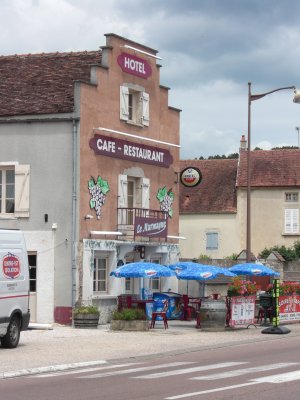 Along the way, we drove through fields of the usual grain, colza, and a little corn (along the edges of the road, I spotted, among others, wild parsnip, cornflowers, poppies, daisies, vetch, lupins, many of what botanists fondly call "damn little yellow composites," great mulleins, teasels, yellow owl clover, "eglantine" wild roses, and nettles. We also passed through large sections of forest, of ash, locust, charme (hornbeam), "sycamore" (i.e., european maples), nut trees, and some oaks; elderberries were in bloom in the bright spots.
Along the way, we drove through fields of the usual grain, colza, and a little corn (along the edges of the road, I spotted, among others, wild parsnip, cornflowers, poppies, daisies, vetch, lupins, many of what botanists fondly call "damn little yellow composites," great mulleins, teasels, yellow owl clover, "eglantine" wild roses, and nettles. We also passed through large sections of forest, of ash, locust, charme (hornbeam), "sycamore" (i.e., european maples), nut trees, and some oaks; elderberries were in bloom in the bright spots.
Our route also took us right through the field of windmills we had glimpsed a couple of days earlier on our way south to Dijon, and I was finally able to get a photo of one. It's really big! We were probably still a mile or two from it, and those are full-grown oaks at its foot. I wonder how many kilowatt hours one of those babies puts out!
We got to the final turn toward Fontenay at lunchtime. The abbey itself is isolated out in the countryside and wasn't likely to offer much in the way of restaurants, so we stopped at Le Marmagne, in the village of the same name. It seemed to have a mixed clientel—tourists come to see Fontenay, who mostly sat outside on the terrace, and local working men, who mostly sat inside near the bar. We sat inside and got to observe a whole slice of local life. The hostess/waitress/proprietress, whom I can only think of as the landlady, reminded me strongly of Jennifer Saunders in Muppet Treasure Island (though she wasn't anywhere near as ugly or as loud).
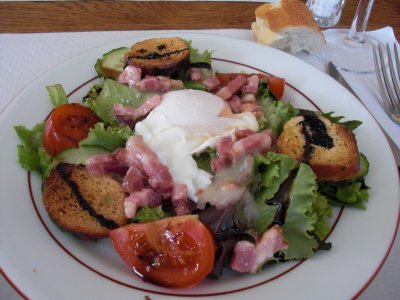
 I had a salad with lardons, poached egg, and toast. In addition to the regular vinaigrette on the lettuce and tomatoes, the toasts were drizzled with balsamic syrup—really good! The salad was smaller than some (it was intended as an appetizer), so I had dessert, a "coupe iceberg" (mint-chocolate-chip ice cream, crême de menthe, and whipped cream).
I had a salad with lardons, poached egg, and toast. In addition to the regular vinaigrette on the lettuce and tomatoes, the toasts were drizzled with balsamic syrup—really good! The salad was smaller than some (it was intended as an appetizer), so I had dessert, a "coupe iceberg" (mint-chocolate-chip ice cream, crême de menthe, and whipped cream).
According to a sign hanging on the hors d'oeuvre buffet, the establishment had just adopted the formula we've seen elsewhere in restaurants serving working men in France. For a fixed price (28 euros in this case), the client enters, goes straight to the hor d'oeuvre bar, and fills a plate (with, e.g., grated carrot salad, slices of pâté, marinated mushrooms, celery-root remoulade). While he eats that, the landlady comes around to ask which of the two plats du jour he wants for his main course (in this case, fish with boiled potatotes or skewer of pork with fries) and which dessert (in this case, black-currant sorbet or fromage blanc). A pretty good deal.
While we were there, another guy came who exchanged cordial greetings with all the others, both arriving and leaving—everyone there seemed to know everyone else, and conversations spanned more than one table—and was clearly local, but he ordered from the menu rather than following the fomula, and whereas all the others were in t-shirts, he wore a well-worn tweed jacket and sat at a table by himself. We speculate that he was the local accountant, banker, lawyer, or some such, and therefore not "one of the working men."
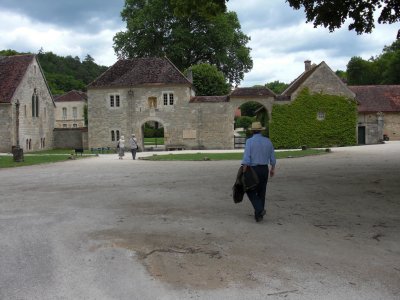
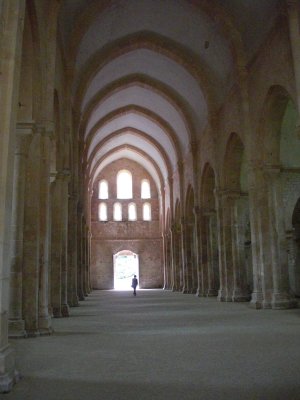 Fontenay itself was beautiful. At its height, it housed 300 Cistercian monks and lay brothers and was entirely self-sufficient. At the left, David approaches the front gate, wearing his new hat. At the right is a view down the nave of the abbey church. Notice how plain the decor is; this is apparently a tenet of the Benedictine rule the Cistercians lived under—nothing frivolous like decoration (or eating meat, or sleeping in a heated room or with anything but a straw pallette between you and the stone floor). Notice also the pointed arches, some of the earliest in Europe—our guide mentioned particularly that the Cistercian monks were very advanced in their architectural thinking. The whole place is now a UNESCO World Heritage Site.
Fontenay itself was beautiful. At its height, it housed 300 Cistercian monks and lay brothers and was entirely self-sufficient. At the left, David approaches the front gate, wearing his new hat. At the right is a view down the nave of the abbey church. Notice how plain the decor is; this is apparently a tenet of the Benedictine rule the Cistercians lived under—nothing frivolous like decoration (or eating meat, or sleeping in a heated room or with anything but a straw pallette between you and the stone floor). Notice also the pointed arches, some of the earliest in Europe—our guide mentioned particularly that the Cistercian monks were very advanced in their architectural thinking. The whole place is now a UNESCO World Heritage Site.
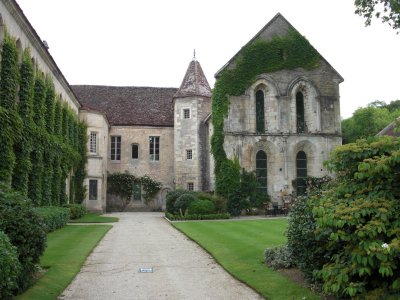 The abbey declined in size and importance over the centuries but persisted until the French revolution, when the last of the monks were evicted; it hasn't served as an abbey or monastary since then. The buildings, like all property of the church were claimed as state property, were sold, and became a paper mill. In 1906 it was bought by a private individual who set about restoring it. He ripped out all the paper-millery, cleaned up and replanted the gardens, and finally opened it for tours. His descendents apparently still live there. The photo at the left is of one of the buildings marked "private."
The abbey declined in size and importance over the centuries but persisted until the French revolution, when the last of the monks were evicted; it hasn't served as an abbey or monastary since then. The buildings, like all property of the church were claimed as state property, were sold, and became a paper mill. In 1906 it was bought by a private individual who set about restoring it. He ripped out all the paper-millery, cleaned up and replanted the gardens, and finally opened it for tours. His descendents apparently still live there. The photo at the left is of one of the buildings marked "private."
The compound originally included a very large and active forge. Demonstrations are given there, but not the week we visited. To my delight, though, the displays included an actual, working hydraulic hammer, similar to the one we saw video of in Troyes! It was a cooperative project among a number of European vocational-technical high schools. Each school built a working miniature model of such a hammer (all the models were on display, most of them still working), then each school completed one component of the full-size one and brought it Fontenay for installation. It wasn't working while we were there (they have no way to stop the water wheel, and the hammer apparently makes a heck of a racket, so they disengage it when it's not in use for a demo).
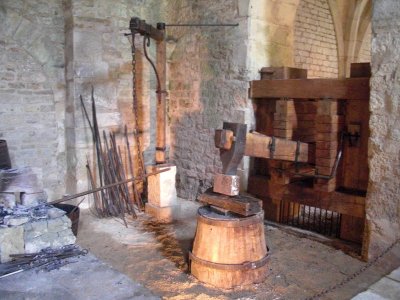
 At the left is the head of the hammer, resting on a wooden block while disabled. At the right is the view from the other side of the wall the hammer shaft passes through. Outside, where you can see sunlight streaming in, is a huge undershot waterwheel, which turns the massive shaft (cut from a single oak trunk). About midway between the waterwheel and the end in the foreground is a ring of iron cogs that turn continuously. When we were there, the hammer shaft (at the left) had been pulled away from the cogs, but to start the hammer, you shove it just a little closer to the cogs, so that a cog engages a little stirrup on the shaft every second or so, forcing the shaft down, and thus lifting the hammer head, until that cog slips loose and lets the hammer head fall, only to be lifted by the next cog.
At the left is the head of the hammer, resting on a wooden block while disabled. At the right is the view from the other side of the wall the hammer shaft passes through. Outside, where you can see sunlight streaming in, is a huge undershot waterwheel, which turns the massive shaft (cut from a single oak trunk). About midway between the waterwheel and the end in the foreground is a ring of iron cogs that turn continuously. When we were there, the hammer shaft (at the left) had been pulled away from the cogs, but to start the hammer, you shove it just a little closer to the cogs, so that a cog engages a little stirrup on the shaft every second or so, forcing the shaft down, and thus lifting the hammer head, until that cog slips loose and lets the hammer head fall, only to be lifted by the next cog.
The forge building also housed a demonstration of roof tiling—a life-size piece of roof, half tiled, with all the various parts and pieces labeled. Very helpful. Another building housed the monks' original bread oven and a set of tools for its use. The baker heated the oven by filling it with wood and setting the wood on fire. The tools included a large, hook-shaped scraper on a long pole for pulling the embers out once the fire had burned down, a pole with a rag nailed to the end that was dipped in water and used to swab out the ashes, and a long-handled baker's peel with which to put bread dough into the hot oven, right on the stone oven floor, and remove it again later.

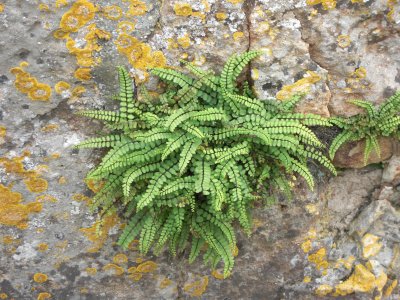 The grounds were lovely, laid out as formal gardens and meticulously maintained. We were just a little too early to see the lilies in bloom—in every flower bed they were standing 4-5 feet high, with bulging six-inch buds on the point of opening. One very large plane tree (what we would call a sycamore in the U.S.) dates from 1789 (just as the monks were leaving). Little waterfalls and fountains were everywhere (hence the name "Fontenay"); in one of them a little patch of watercress had taken root and was blooming. The monks originally raised their own fish—trout that they caught in local streams then fattened up in a pond on the grounds. The pond is gone, but the basin at the bottom of one waterfall has been stocked with dozens of speckled trout (that's just a description; I have no idea of the species), which are clearly large, fat, and happy. I asked what becomes of them and was assured they were fed periodically until they died of old age. These photos are just here for decoration—a view down one side of the elegant cloister and a little spleenwort that was growing out of the wall of one of the buildings. As a final charming touch, ducks were dabbling in the millrace we followed on our way back to our car, complete with busy little fuzzy ducklings.
The grounds were lovely, laid out as formal gardens and meticulously maintained. We were just a little too early to see the lilies in bloom—in every flower bed they were standing 4-5 feet high, with bulging six-inch buds on the point of opening. One very large plane tree (what we would call a sycamore in the U.S.) dates from 1789 (just as the monks were leaving). Little waterfalls and fountains were everywhere (hence the name "Fontenay"); in one of them a little patch of watercress had taken root and was blooming. The monks originally raised their own fish—trout that they caught in local streams then fattened up in a pond on the grounds. The pond is gone, but the basin at the bottom of one waterfall has been stocked with dozens of speckled trout (that's just a description; I have no idea of the species), which are clearly large, fat, and happy. I asked what becomes of them and was assured they were fed periodically until they died of old age. These photos are just here for decoration—a view down one side of the elegant cloister and a little spleenwort that was growing out of the wall of one of the buildings. As a final charming touch, ducks were dabbling in the millrace we followed on our way back to our car, complete with busy little fuzzy ducklings.
Our dinner, back in Dijon, was at Le Pré aux Clercs, one of those places where, on the front of the building, the chef's name is bigger than the name of the restaurant. It was right on the Place de la Liberté, facing the ducal palace, and we were the only people who chose to sit inside, in the calm and elegant dining room, rather than outside on the place, with the foot traffic, diesel bus traffic, and roller-bladers, which we could see just as well through the front windows—chacun à son goût. As usual, we fell for the multicourse tasting menu.
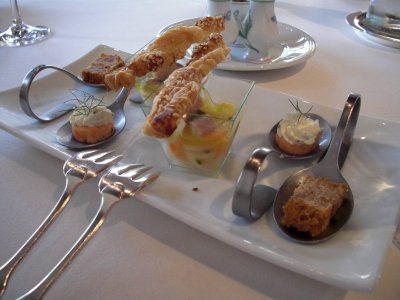 Amuse bouche: A small, rectangular cold sandwich of pain d'épices and tuna (sounds odd but was surprisingly good); a little disk of cold salmon mousse topped with dill cream (delicious!); and a glass filled with shredded vegetables in vinegar and topped with two little pieces of pickled herring and a puff-pastry fleuron. The herring was okay (though David's not fond of it in any form), but the vegetables were too sour to eat.
Amuse bouche: A small, rectangular cold sandwich of pain d'épices and tuna (sounds odd but was surprisingly good); a little disk of cold salmon mousse topped with dill cream (delicious!); and a glass filled with shredded vegetables in vinegar and topped with two little pieces of pickled herring and a puff-pastry fleuron. The herring was okay (though David's not fond of it in any form), but the vegetables were too sour to eat.
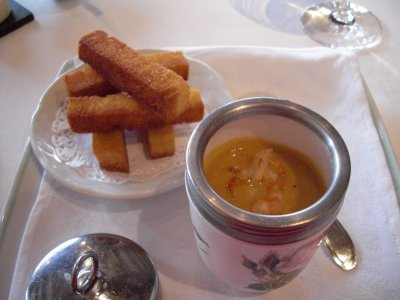 First course: Coddled egg with langoustine sauce and toast. Each egg was broken into a china egg coddler, the lid of which was screwed on before it was lowered into boiling water to cook the egg (to the soft-boiled stage). The lid was then removed and the egg covered with the sauce and a couple of langoustine tails. The toast was cut into square logs (for dipping) and fried crisp in butter. Very good!
First course: Coddled egg with langoustine sauce and toast. Each egg was broken into a china egg coddler, the lid of which was screwed on before it was lowered into boiling water to cook the egg (to the soft-boiled stage). The lid was then removed and the egg covered with the sauce and a couple of langoustine tails. The toast was cut into square logs (for dipping) and fried crisp in butter. Very good!
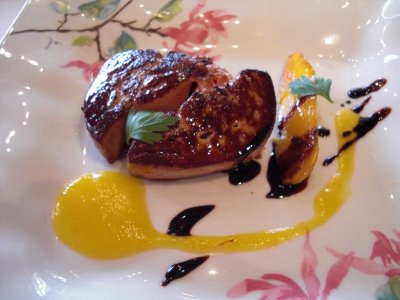 Second course: Foie gras seared and laid over a mound of tiny, slightly sweet croutons of pain d'épices and sided by a spear of roasted mango, mango purée, and balsamic syrup. The liver was exquisite and combined beautifully with the croutons and accompaniments.
Second course: Foie gras seared and laid over a mound of tiny, slightly sweet croutons of pain d'épices and sided by a spear of roasted mango, mango purée, and balsamic syrup. The liver was exquisite and combined beautifully with the croutons and accompaniments.
Third course: Sautéed filet of St. Pierre (Zeus faber, a fish) over a timbale of caramelized fennel, surrounded by a hazelnut-thyme vinaigrette. Very good.
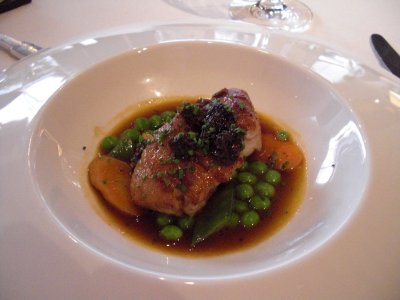 Fourth course: Sweetbreads braised with fresh morels and surrounded by broth. I found the peas and carrots perfectly good but irrelevant to the dish. The sweetbreads, like the liver, were exquisite; the texture was perfect.
Fourth course: Sweetbreads braised with fresh morels and surrounded by broth. I found the peas and carrots perfectly good but irrelevant to the dish. The sweetbreads, like the liver, were exquisite; the texture was perfect.
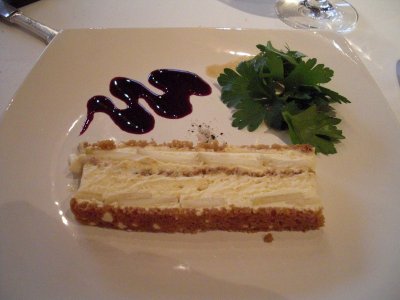 Fifth course, cheese: Rather than choosing from the cheese trolley, we opted for the "prepared" cheese course of the evening, which was odd (the dish, not our choice of it). It was based on Époisse, which is famous for being strong-flavored and which I usually find more redolent than necessary of the barnyard, which was layered with pain d'épices (again!) and lightly cooked sliced apple. It was accompanied by a little pile of vinaigrette-dressed parsley leaves, a pool of red-wine reduction, and a pinch of sea salt. It turned out to be inoffensive and even tasty, but I wouldn't order it again.
Fifth course, cheese: Rather than choosing from the cheese trolley, we opted for the "prepared" cheese course of the evening, which was odd (the dish, not our choice of it). It was based on Époisse, which is famous for being strong-flavored and which I usually find more redolent than necessary of the barnyard, which was layered with pain d'épices (again!) and lightly cooked sliced apple. It was accompanied by a little pile of vinaigrette-dressed parsley leaves, a pool of red-wine reduction, and a pinch of sea salt. It turned out to be inoffensive and even tasty, but I wouldn't order it again.
 Dessert came in three parts: Mignardises (tiny pecan tarts, almond tuiles, lemon cakes, and excellent black-currant fruit paste), a little white ceramic pot of chocolate-caramel cream topped with whipped caramelized milk (delicious but so rich I couldn't finish it), and the assortment shown here: A wedge of mango ice cream encrusted with crushed pistachios, a miniature crême brulée, half a little vanilla cupcake with whipped cream, and a small strawberry-and-raspberry tart (served, as is increasingly common, on a slab of slate).
Dessert came in three parts: Mignardises (tiny pecan tarts, almond tuiles, lemon cakes, and excellent black-currant fruit paste), a little white ceramic pot of chocolate-caramel cream topped with whipped caramelized milk (delicious but so rich I couldn't finish it), and the assortment shown here: A wedge of mango ice cream encrusted with crushed pistachios, a miniature crême brulée, half a little vanilla cupcake with whipped cream, and a small strawberry-and-raspberry tart (served, as is increasingly common, on a slab of slate).
 Here's David's day-time shot of the semicircular Place de la Liberté, showing one of its three fountains; the two right-hand umbrellas are outside our restaurant. The flat side of the place is immediately across the street from the front wall and gate of the ducal palace. (The ducal kitchens never did open while we were in town. )
Tomorrow, it's off to Gilly-les-Cîteaux!
Here's David's day-time shot of the semicircular Place de la Liberté, showing one of its three fountains; the two right-hand umbrellas are outside our restaurant. The flat side of the place is immediately across the street from the front wall and gate of the ducal palace. (The ducal kitchens never did open while we were in town. )
Tomorrow, it's off to Gilly-les-Cîteaux!
previous entry
List of Entries
next entry

 On Friday morning, our last full day in Dijon, we set out on an expedition to visit the Abbey of Fontenay, the second of three founded in the 12th century by Bernard de Clairvaux (yes, the St. Bernard) and one of the oldest Cistercian establishments in France (the very oldest to be preserved as well as it is). Bernard was considered a "world-changing individual"— in his time, more influential than the pope. The trip involved retracing our steps part of the way to Troyes, but we wouldn't be travelling that direction again this year, so it seemed worth the detour.
On Friday morning, our last full day in Dijon, we set out on an expedition to visit the Abbey of Fontenay, the second of three founded in the 12th century by Bernard de Clairvaux (yes, the St. Bernard) and one of the oldest Cistercian establishments in France (the very oldest to be preserved as well as it is). Bernard was considered a "world-changing individual"— in his time, more influential than the pope. The trip involved retracing our steps part of the way to Troyes, but we wouldn't be travelling that direction again this year, so it seemed worth the detour. 
 Along the way, we drove through fields of the usual grain, colza, and a little corn (along the edges of the road, I spotted, among others, wild parsnip, cornflowers, poppies, daisies, vetch, lupins, many of what botanists fondly call "damn little yellow composites," great mulleins, teasels, yellow owl clover, "eglantine" wild roses, and nettles. We also passed through large sections of forest, of ash, locust, charme (hornbeam), "sycamore" (i.e., european maples), nut trees, and some oaks; elderberries were in bloom in the bright spots.
Along the way, we drove through fields of the usual grain, colza, and a little corn (along the edges of the road, I spotted, among others, wild parsnip, cornflowers, poppies, daisies, vetch, lupins, many of what botanists fondly call "damn little yellow composites," great mulleins, teasels, yellow owl clover, "eglantine" wild roses, and nettles. We also passed through large sections of forest, of ash, locust, charme (hornbeam), "sycamore" (i.e., european maples), nut trees, and some oaks; elderberries were in bloom in the bright spots.
 I had a salad with lardons, poached egg, and toast. In addition to the regular vinaigrette on the lettuce and tomatoes, the toasts were drizzled with balsamic syrup—really good! The salad was smaller than some (it was intended as an appetizer), so I had dessert, a "coupe iceberg" (mint-chocolate-chip ice cream, crême de menthe, and whipped cream).
I had a salad with lardons, poached egg, and toast. In addition to the regular vinaigrette on the lettuce and tomatoes, the toasts were drizzled with balsamic syrup—really good! The salad was smaller than some (it was intended as an appetizer), so I had dessert, a "coupe iceberg" (mint-chocolate-chip ice cream, crême de menthe, and whipped cream).
 Fontenay itself was beautiful. At its height, it housed 300 Cistercian monks and lay brothers and was entirely self-sufficient. At the left, David approaches the front gate, wearing his new hat. At the right is a view down the nave of the abbey church. Notice how plain the decor is; this is apparently a tenet of the Benedictine rule the Cistercians lived under—nothing frivolous like decoration (or eating meat, or sleeping in a heated room or with anything but a straw pallette between you and the stone floor). Notice also the pointed arches, some of the earliest in Europe—our guide mentioned particularly that the Cistercian monks were very advanced in their architectural thinking. The whole place is now a UNESCO World Heritage Site.
Fontenay itself was beautiful. At its height, it housed 300 Cistercian monks and lay brothers and was entirely self-sufficient. At the left, David approaches the front gate, wearing his new hat. At the right is a view down the nave of the abbey church. Notice how plain the decor is; this is apparently a tenet of the Benedictine rule the Cistercians lived under—nothing frivolous like decoration (or eating meat, or sleeping in a heated room or with anything but a straw pallette between you and the stone floor). Notice also the pointed arches, some of the earliest in Europe—our guide mentioned particularly that the Cistercian monks were very advanced in their architectural thinking. The whole place is now a UNESCO World Heritage Site.  The abbey declined in size and importance over the centuries but persisted until the French revolution, when the last of the monks were evicted; it hasn't served as an abbey or monastary since then. The buildings, like all property of the church were claimed as state property, were sold, and became a paper mill. In 1906 it was bought by a private individual who set about restoring it. He ripped out all the paper-millery, cleaned up and replanted the gardens, and finally opened it for tours. His descendents apparently still live there. The photo at the left is of one of the buildings marked "private."
The abbey declined in size and importance over the centuries but persisted until the French revolution, when the last of the monks were evicted; it hasn't served as an abbey or monastary since then. The buildings, like all property of the church were claimed as state property, were sold, and became a paper mill. In 1906 it was bought by a private individual who set about restoring it. He ripped out all the paper-millery, cleaned up and replanted the gardens, and finally opened it for tours. His descendents apparently still live there. The photo at the left is of one of the buildings marked "private."

 At the left is the head of the hammer, resting on a wooden block while disabled. At the right is the view from the other side of the wall the hammer shaft passes through. Outside, where you can see sunlight streaming in, is a huge undershot waterwheel, which turns the massive shaft (cut from a single oak trunk). About midway between the waterwheel and the end in the foreground is a ring of iron cogs that turn continuously. When we were there, the hammer shaft (at the left) had been pulled away from the cogs, but to start the hammer, you shove it just a little closer to the cogs, so that a cog engages a little stirrup on the shaft every second or so, forcing the shaft down, and thus lifting the hammer head, until that cog slips loose and lets the hammer head fall, only to be lifted by the next cog.
At the left is the head of the hammer, resting on a wooden block while disabled. At the right is the view from the other side of the wall the hammer shaft passes through. Outside, where you can see sunlight streaming in, is a huge undershot waterwheel, which turns the massive shaft (cut from a single oak trunk). About midway between the waterwheel and the end in the foreground is a ring of iron cogs that turn continuously. When we were there, the hammer shaft (at the left) had been pulled away from the cogs, but to start the hammer, you shove it just a little closer to the cogs, so that a cog engages a little stirrup on the shaft every second or so, forcing the shaft down, and thus lifting the hammer head, until that cog slips loose and lets the hammer head fall, only to be lifted by the next cog.
 The grounds were lovely, laid out as formal gardens and meticulously maintained. We were just a little too early to see the lilies in bloom—in every flower bed they were standing 4-5 feet high, with bulging six-inch buds on the point of opening. One very large plane tree (what we would call a sycamore in the U.S.) dates from 1789 (just as the monks were leaving). Little waterfalls and fountains were everywhere (hence the name "Fontenay"); in one of them a little patch of watercress had taken root and was blooming. The monks originally raised their own fish—trout that they caught in local streams then fattened up in a pond on the grounds. The pond is gone, but the basin at the bottom of one waterfall has been stocked with dozens of speckled trout (that's just a description; I have no idea of the species), which are clearly large, fat, and happy. I asked what becomes of them and was assured they were fed periodically until they died of old age. These photos are just here for decoration—a view down one side of the elegant cloister and a little spleenwort that was growing out of the wall of one of the buildings. As a final charming touch, ducks were dabbling in the millrace we followed on our way back to our car, complete with busy little fuzzy ducklings.
The grounds were lovely, laid out as formal gardens and meticulously maintained. We were just a little too early to see the lilies in bloom—in every flower bed they were standing 4-5 feet high, with bulging six-inch buds on the point of opening. One very large plane tree (what we would call a sycamore in the U.S.) dates from 1789 (just as the monks were leaving). Little waterfalls and fountains were everywhere (hence the name "Fontenay"); in one of them a little patch of watercress had taken root and was blooming. The monks originally raised their own fish—trout that they caught in local streams then fattened up in a pond on the grounds. The pond is gone, but the basin at the bottom of one waterfall has been stocked with dozens of speckled trout (that's just a description; I have no idea of the species), which are clearly large, fat, and happy. I asked what becomes of them and was assured they were fed periodically until they died of old age. These photos are just here for decoration—a view down one side of the elegant cloister and a little spleenwort that was growing out of the wall of one of the buildings. As a final charming touch, ducks were dabbling in the millrace we followed on our way back to our car, complete with busy little fuzzy ducklings. Amuse bouche: A small, rectangular cold sandwich of pain d'épices and tuna (sounds odd but was surprisingly good); a little disk of cold salmon mousse topped with dill cream (delicious!); and a glass filled with shredded vegetables in vinegar and topped with two little pieces of pickled herring and a puff-pastry fleuron. The herring was okay (though David's not fond of it in any form), but the vegetables were too sour to eat.
Amuse bouche: A small, rectangular cold sandwich of pain d'épices and tuna (sounds odd but was surprisingly good); a little disk of cold salmon mousse topped with dill cream (delicious!); and a glass filled with shredded vegetables in vinegar and topped with two little pieces of pickled herring and a puff-pastry fleuron. The herring was okay (though David's not fond of it in any form), but the vegetables were too sour to eat. First course: Coddled egg with langoustine sauce and toast. Each egg was broken into a china egg coddler, the lid of which was screwed on before it was lowered into boiling water to cook the egg (to the soft-boiled stage). The lid was then removed and the egg covered with the sauce and a couple of langoustine tails. The toast was cut into square logs (for dipping) and fried crisp in butter. Very good!
First course: Coddled egg with langoustine sauce and toast. Each egg was broken into a china egg coddler, the lid of which was screwed on before it was lowered into boiling water to cook the egg (to the soft-boiled stage). The lid was then removed and the egg covered with the sauce and a couple of langoustine tails. The toast was cut into square logs (for dipping) and fried crisp in butter. Very good! Second course: Foie gras seared and laid over a mound of tiny, slightly sweet croutons of pain d'épices and sided by a spear of roasted mango, mango purée, and balsamic syrup. The liver was exquisite and combined beautifully with the croutons and accompaniments.
Second course: Foie gras seared and laid over a mound of tiny, slightly sweet croutons of pain d'épices and sided by a spear of roasted mango, mango purée, and balsamic syrup. The liver was exquisite and combined beautifully with the croutons and accompaniments. Fourth course: Sweetbreads braised with fresh morels and surrounded by broth. I found the peas and carrots perfectly good but irrelevant to the dish. The sweetbreads, like the liver, were exquisite; the texture was perfect.
Fourth course: Sweetbreads braised with fresh morels and surrounded by broth. I found the peas and carrots perfectly good but irrelevant to the dish. The sweetbreads, like the liver, were exquisite; the texture was perfect. Fifth course, cheese: Rather than choosing from the cheese trolley, we opted for the "prepared" cheese course of the evening, which was odd (the dish, not our choice of it). It was based on Époisse, which is famous for being strong-flavored and which I usually find more redolent than necessary of the barnyard, which was layered with pain d'épices (again!) and lightly cooked sliced apple. It was accompanied by a little pile of vinaigrette-dressed parsley leaves, a pool of red-wine reduction, and a pinch of sea salt. It turned out to be inoffensive and even tasty, but I wouldn't order it again.
Fifth course, cheese: Rather than choosing from the cheese trolley, we opted for the "prepared" cheese course of the evening, which was odd (the dish, not our choice of it). It was based on Époisse, which is famous for being strong-flavored and which I usually find more redolent than necessary of the barnyard, which was layered with pain d'épices (again!) and lightly cooked sliced apple. It was accompanied by a little pile of vinaigrette-dressed parsley leaves, a pool of red-wine reduction, and a pinch of sea salt. It turned out to be inoffensive and even tasty, but I wouldn't order it again. Dessert came in three parts: Mignardises (tiny pecan tarts, almond tuiles, lemon cakes, and excellent black-currant fruit paste), a little white ceramic pot of chocolate-caramel cream topped with whipped caramelized milk (delicious but so rich I couldn't finish it), and the assortment shown here: A wedge of mango ice cream encrusted with crushed pistachios, a miniature crême brulée, half a little vanilla cupcake with whipped cream, and a small strawberry-and-raspberry tart (served, as is increasingly common, on a slab of slate).
Dessert came in three parts: Mignardises (tiny pecan tarts, almond tuiles, lemon cakes, and excellent black-currant fruit paste), a little white ceramic pot of chocolate-caramel cream topped with whipped caramelized milk (delicious but so rich I couldn't finish it), and the assortment shown here: A wedge of mango ice cream encrusted with crushed pistachios, a miniature crême brulée, half a little vanilla cupcake with whipped cream, and a small strawberry-and-raspberry tart (served, as is increasingly common, on a slab of slate). Here's David's day-time shot of the semicircular Place de la Liberté, showing one of its three fountains; the two right-hand umbrellas are outside our restaurant. The flat side of the place is immediately across the street from the front wall and gate of the ducal palace. (The ducal kitchens never did open while we were in town. )
Tomorrow, it's off to Gilly-les-Cîteaux!
Here's David's day-time shot of the semicircular Place de la Liberté, showing one of its three fountains; the two right-hand umbrellas are outside our restaurant. The flat side of the place is immediately across the street from the front wall and gate of the ducal palace. (The ducal kitchens never did open while we were in town. )
Tomorrow, it's off to Gilly-les-Cîteaux!